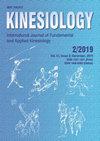Comparing external total load, acceleration and deceleration outputs in elite basketball players across positions during match play
IF 0.9
4区 医学
Q4 REHABILITATION
引用次数: 44
Abstract
The aim of this study was to compare external load, calculated by an accelerometer training load model, the number and intensity of accelerations and decelerations and the acceleration:deceleration ratio between playing positions during basketball matches. Twelve elite male basketball players (mean±SD, age: 25.5±5.2 years (range: 19-36 years); 201.4±8.6 cm; body mass: 98.4±12.6 kg) were monitored during two official matches. An accelerometer training load model and the number of accelerations and decelerations were used to assess the physical demands. Magnitude-based inferences and effect sizes (ES) were used to assess possible differences between positions: Point Guards (PG), Shooting Guards (SG), Small Forwards (SF), Power Forwards (PF) and Centers (C). Elite basketball players in all positions presented higher maximal decelerations than accelerations (ES=2.70 to 6.87) whereas the number of accelerations at moderate intensities was higher than deceleration (ES=0.54 to 3.12). Furthermore, the acceleration:deceleration ratio (>3 m∙s-2) was significantly lower in players on the perimeter (PG and SG) than in PF and C (ES=1.03 to 2.21). Finally, PF had the lowest total external load (ES=0.67 to 1.18). These data allow us to have a greater knowledge of the external demands in matches and this information could be used in the planning of training programs.比较优秀篮球运动员在比赛中不同位置的外部总负荷、加速和减速输出
本研究的目的是比较由加速度计训练负荷模型计算的外负荷、篮球比赛中加减速的次数和强度以及打球位置间的加减速比。优秀男子篮球运动员12名(平均±SD,年龄25.5±5.2岁,范围19-36岁);201.4±8.6厘米;在两场正式比赛中监测体重:98.4±12.6 kg)。使用加速度计训练负荷模型和加减速次数来评估体能需求。采用基于量级的推断和效应量(ES)来评估不同位置之间可能存在的差异:控球后卫(PG)、得分后卫(SG)、小前锋(SF)、大前锋(PF)和中锋(C)。优秀篮球运动员在所有位置上的最大减速度都高于加速(ES=2.70 ~ 6.87),而中等强度下的加速次数高于减速(ES=0.54 ~ 3.12)。此外,外线球员(后卫和后卫)的加减速比(>.3 m∙s-2)显著低于前锋和C (ES=1.03 ~ 2.21)。最后,PF的总外负荷最低(ES=0.67 ~ 1.18)。这些数据使我们能够更好地了解比赛中的外部需求,这些信息可以用于制定训练计划。
本文章由计算机程序翻译,如有差异,请以英文原文为准。
求助全文
约1分钟内获得全文
求助全文
来源期刊

Kinesiology
REHABILITATION-SPORT SCIENCES
CiteScore
1.90
自引率
8.30%
发文量
16
审稿时长
>12 weeks
期刊介绍:
Kinesiology – International Journal of Fundamental and Applied Kinesiology (print ISSN 1331- 1441, online ISSN 1848-638X) publishes twice a year scientific papers and other written material from kinesiology (a scientific discipline which investigates art and science of human movement; in the meaning and scope close to the idiom “sport sciences”) and other adjacent human sciences focused on sport and exercise, primarily from anthropology (biological and cultural alike), medicine, sociology, psychology, natural sciences and mathematics applied to sport in its broadest sense, history, and others. Contributions of high scientific interest, including also results of theoretical analyses and their practical application in physical education, sport, physical recreation and kinesitherapy, are accepted for publication. The following sections define the scope of the journal: Sport and sports activities, Physical education, Recreation/leisure, Kinesiological anthropology, Training methods, Biology of sport and exercise, Sports medicine and physiology of sport, Biomechanics, History of sport and Book reviews with news.
 求助内容:
求助内容: 应助结果提醒方式:
应助结果提醒方式:


